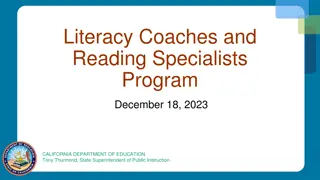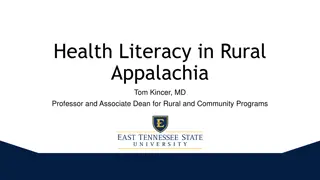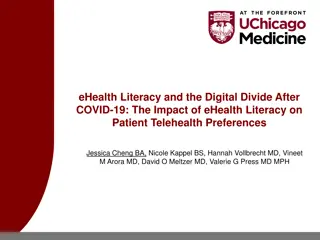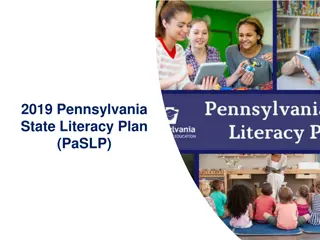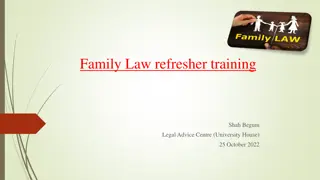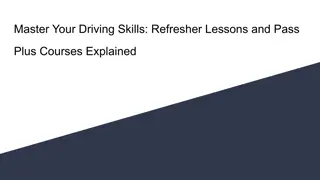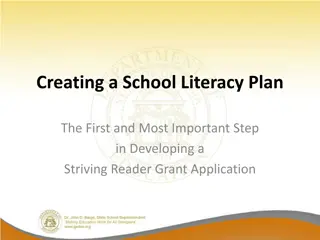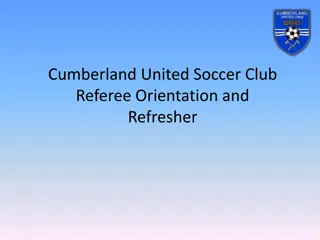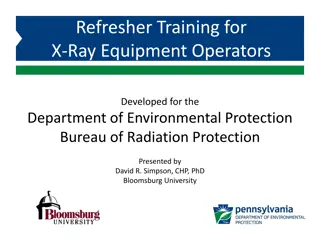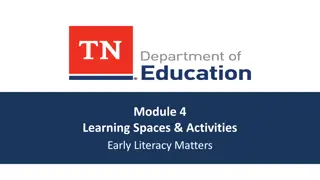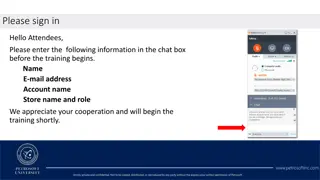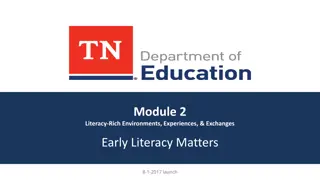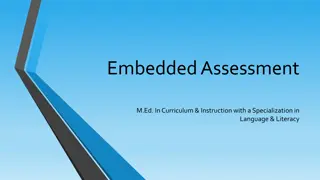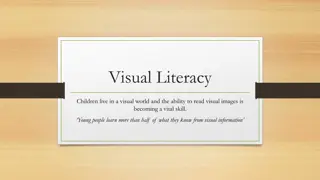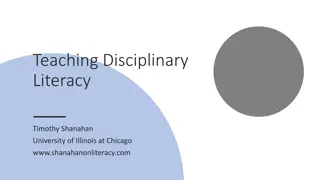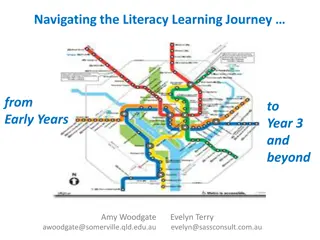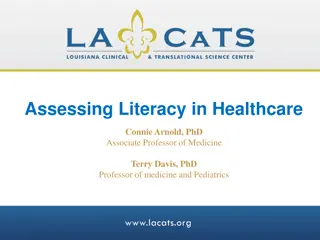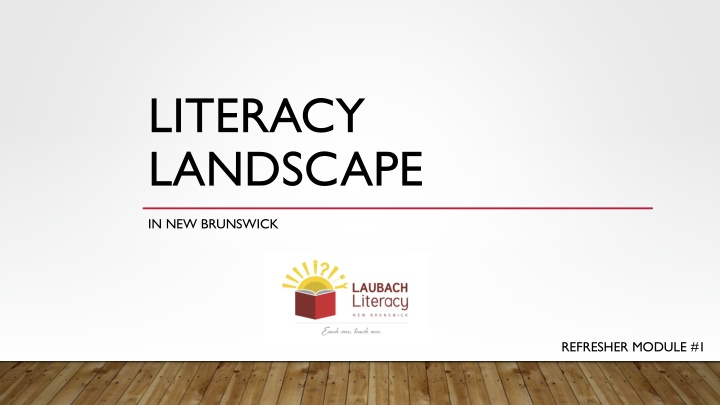
Literacy Landscape in New Brunswick
Explore the adult literacy landscape in New Brunswick, including defining literacy, measuring literacy through prose/document literacy, numeracy, and PS-TRE, and understanding proficiency levels. Dive into the importance of literacy in achieving goals, making decisions, problem-solving, and full community participation.
Download Presentation

Please find below an Image/Link to download the presentation.
The content on the website is provided AS IS for your information and personal use only. It may not be sold, licensed, or shared on other websites without obtaining consent from the author. If you encounter any issues during the download, it is possible that the publisher has removed the file from their server.
You are allowed to download the files provided on this website for personal or commercial use, subject to the condition that they are used lawfully. All files are the property of their respective owners.
The content on the website is provided AS IS for your information and personal use only. It may not be sold, licensed, or shared on other websites without obtaining consent from the author.
E N D
Presentation Transcript
LITERACY LANDSCAPE IN NEW BRUNSWICK REFRESHER MODULE #1
INTRODUCTION In this presentation we will: Define literacy and provide you with some literacy statistics Provide you with a mini-snapshot of the adult literacy landscape in New Brunswick, with respect to who is doing what and why. Review Laubach Literacy NB s role its mission, and values, and its strategic plan.
DEFINING LITERACY Literacy is the ability to read, write, speak and listen as well as to use numeracy and technology at a level that enables people to express and understand ideas and opinions, to make decisions and solve problems, to achieve their goals, and to participate fully in their community and in wider society.
MEASURING LITERACY Three types of literacy are measured by Programme for the International Assessment of Adult Competencies Prose/Document Literacy Respondents are measured for their ability to engage with written texts (print-based and digital) and thereby participate in society, achieve goals, and develop their knowledge and potential. This requires accessing, identifying, and processing information from a variety of texts that relate to a range of settings. Numeracy Respondents are measured for their ability to engage with mathematical information in order to manage the mathematical demands of a range of situations in everyday life. This requires understanding mathematical content and ideas (e.g., quantities, numbers, dimensions, relationships), and the representation of that content (e.g., objects, pictures, diagrams, graphs). PS-TRE Respondents are measured for their ability to use digital technology, communications tools, and networks to acquire and evaluate information, communicate with others, and perform practical tasks. This requires understanding technology (e.g., hardware, software applications, commands and functions) and solving problems with it. Measurement is divided into two different but related parameters: 1) familiarity with computers and how to use them; and 2) the ability to solve problems commonly encountered in a technology- rich world.
LITERACY PROFICIENCY LEVELS Level 1 has few basic skills, great deal of difficulty with text Level 2 has limited skills, cannot read well, can deal only with materials that is simply and clearly laid out. Level 3 has a basic skill level but may have problems with more complex tasks. (Level 3 is considered the minimum skill level needed for successful participation in society.) Levels 4 & 5 have high levels of literacy with a wide range of reading skills and many strategies for dealing with complex materials. Individuals at this level can meet most reading demands and can handle new reading challenges
NUMERACY PROCIENCY LEVELS Level 1 Tasks at this level require the respondent to carry out basic mathematical processes in common, concrete contexts where the mathematical content is explicit with little text. Tasks usually require simple one-step or simple processes involving counting; sorting; performing basic arithmetic operations; understanding simple per cents such as 50%. Level 2 Tasks in this level require the respondent to identify and act on mathematical information and ideas embedded in a range of common contexts where the mathematical content is fairly explicit or visual. Tasks tend to require the application of two or more steps or processes. Level 3 Tasks at this level require the respondent to understand mathematical information that may be less explicit. Tasks require several steps and may involve the choice of problem-solving strategies and relevant processes. Levels 4 & 5 Tasks at this level require the respondent to understand a broad range of mathematical information that may be complex, abstract or embedded in unfamiliar contexts. These tasks involve undertaking multiple steps and choosing relevant problem-solving strategies and processes.
PS-TRE PROFICIENCY LEVELS Below Level 1 Tasks are based on well-defined problems involving the use of only one function within a generic interface to meet one explicit criterion without any categorical, inferential reasoning or transforming of information. Few steps are required and no sub goal has to be generated. Level 1 At this level, tasks typically require the use of widely available and familiar technology applications, such as e-mail software or a web browser. There is little or no navigation required to access to the information or commands required to solve the problem. Level 2 At this level, tasks typically require the use of both generic and specific technology applications. For instance, respondents may have to make use of a novel online form. Some navigation across pages and applications is required to solve the problem. Level 3 At this level, tasks typically require the use of both generic and more specific technology applications. Some navigation across pages and applications is required to solve the problem. The use of tools (e.g., a sort function) is needed to make progress towards the solution.
PIAAC RESULTS - OVERVIEW Canada ranks at the OECD average in literacy, below the OECD average in numeracy, and above the OECD average in PS-TRE. Canada has a higher proportion of its population at the highest proficiency levels in literacy and PS-TRE compared to the OECD average. Canada has a larger proportion of adults at the lowest proficiency levels in all three domains compared to the OECD average.
PIACC HIGHLIGHTS Literacy and numeracy scores are highest at ages 25 to 34. Individuals aged16 to 34 are the most proficient in PS-TRE. Despite higher levels of proficiency in PS-TRE among youth (16 to 24), 9% display proficiency only at the lowest level in PS-TRE. Women and men display similar proficiencies in literacy and in PS-TRE; men have higher numeracy skills than women. Higher education is associated with greater literacy, numeracy, and PS-TRE skills. The employed population displays greater information-processing skills than the unemployed and not in the labour force populations. Workers in managerial and professional occupations display greater information-processing skills than workers in other types of occupations. Literacy and numeracy skills of unemployed and not in the labour force populations are similar. However, not being in the labour force is associated with lower PS-TRE skills compared to the unemployed.
LITERACY ORGS IN NB Community Adult Learning Network (CALNet) Government of NB / DPETL / WorkingNB Laubach Literacy NB and its affiliated councils Saint John Learning Exchange Frontier College Literacy Coalition of NB Multicultural Associations across NB Conseil pour le d veloppement de l alphab tisme et des comp tences des adultes du Nouveau-Brunswick (CODAC NB) And others
LAUBACH LITERACY NB Dr. Frank Laubach s and World Literacy of Canada 1955 Laubach Literacy in Canada 1970 Laubach Literacy in Saint John 1975 Laubach Literacy New Brunswick formed 1981 Laubach Literacy NB Celebrates 40 years
HOW WE ARE ORGANIZED LLNB has a provincial board of volunteers. The Board governs the actions and interests of LLNB as a provincial organization, determining LLNB s strategic direction and priorities, and monitoring its operational finances and activities in relation to the defined strategy. Board committees are formed as needed to provide advice/support for the organization s operation/administration or for short-term projects. LLNB is staffed by a full-time Executive Director who has an extensive experience working with non-profits and directing communications, project/event management and community engagement. LLNB has a part-time volunteer coordinator that support our affiliated councils, their tutors and boards. LLNB tutoring services are delivered through community-based affiliated Laubach Literacy Councils. Each Council has its own volunteer board to govern the actions/interests of LLNB in that area. Funded in part by grants from LLNB, they also raise funds to further support individual community-based programs. LLNB provides tutoring resources and tutor training for all the Councils throughout NB, as well as provides continuing education for all volunteers.LLNB also assists the Councils as needed with community engagement, fund development and marketing.
MISION & VALUES MISSION To provide programs that improve the literacy skills of New Brunswickers VALUES We recognize that literacy is a basic social value. We recognize the right of all New Brunswickers to improve their skills, to access learning opportunities and enjoy a better quality of life. We believe that it is the right of the learner to receive a consistent quality service. We offer learning plans that are contextually relevant to a learner s goals. We will maintain consistent literacy training standards and behave in all matters in a way that trust is preserved. We value the dedication and responsiveness from all LLNB volunteers and staff. We engage with trusted partners and supporters to achieve our purpose. We seek the perspectives of our stakeholders in the development of programs and services.
STRATEGIC PLAN 2021-2026 STRATEGIC IMPACT 1: All New Brunswickers will know about the literacy programs and services we provide. STRATEGIC IMPACT 2: Our adult learners will have a robust selection of programs and services to choose from on their literacy journey. STRATEGIC IMPACT 3: Our councils throughout the province will have the resources they need to meet the expectations of their constituents, both volunteers and learners.
LLNB TUTORS Currently there are 7 LLNB affiliated councils in New Brunswick with more than 200 volunteers/tutors. We depend on our volunteer tutors to provide free, confidential tutoring to adults in communities throughout the province. Laubach Literacy tutors are men and women of all ages from many different backgrounds. These volunteers are committed to helping others improve their reading, writing and basic math skills. Laubach Literacy New Brunswick asks volunteer tutors to commit to working one-to-one with a student for one year for a period of up to 4 hours a week. (Note: this can vary widely depending on the availability/schedule of the learner.)
EXPECTATIONS Laubach Literacy New Brunswick provides tutors with: An orientation to literacy issues Basic tutor training Access to a variety of teaching and learning materials Access to continuing education opportunities Laubach Literacy New Brunswick expects volunteer tutors will: Commit to work with a student 4 hours a week for one year Enter data into the Tutor Portal (database) on a regular basis Participate in continuing education opportunities Maintain total confidentiality regarding their student
WHAT MAKES A GOOD TUTOR A good tutor is: Is responsive to needs of the individual student Facilitates the student s learning Respects the student and the prior knowledge the student brings to the learning experience Is empathetic, caring and interested in the student Is creative in adapting to suit the individual student s needs Is enthusiastic and willing to keep learning Can provide constructive feedback Welcomes the student s input Is well organized for each lesson
LLNB GOALS & TARGETS Since its establishment in New Brunswick in 1975, Laubach Literacy has provided thousands of hours of training and tutoring by hundreds of volunteers. LLNB currently services a number of different target groups, including adults with low level literacy skills, young adults preparing for employment/higher education and new immigrants needing to improve their English reading/writing skills. We seek to help at least 200 learners each year using a combination of one-to-one, small group, and online learning programs and services.
QUESTIONS If you have any questions at any time, please contact your tutor coordinator. Call LLNB: 506-384-6371 (Moncton) Toll Free: 1-877-633-8899 Email: info@llnb.ca

